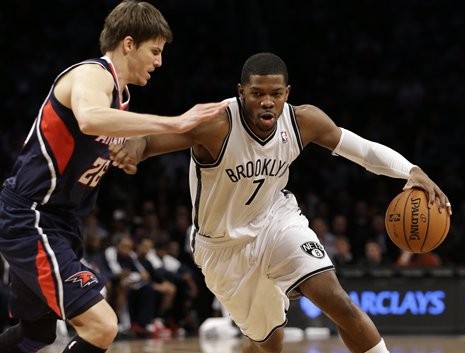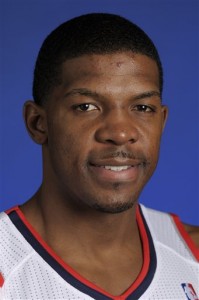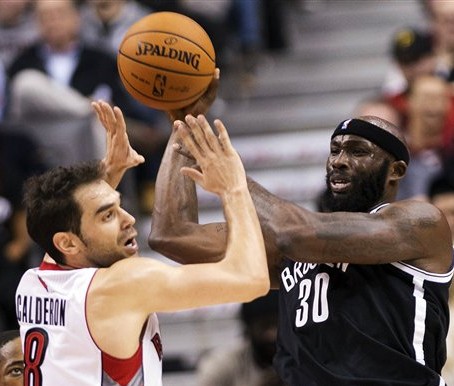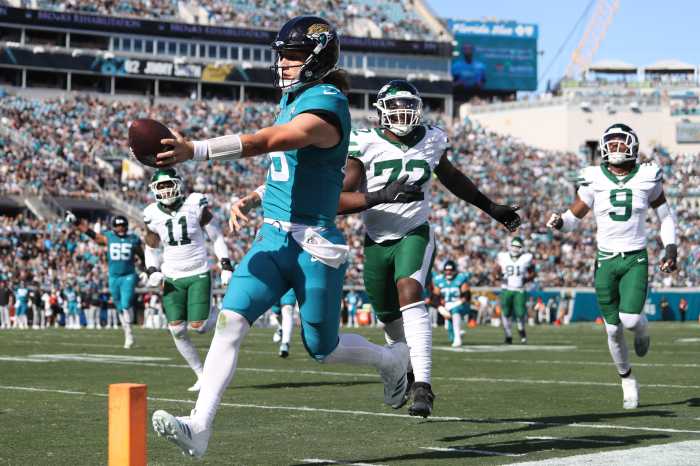With eleven men on the roster, the Brooklyn Nets finished off their rebuild by re-signing starting power forward Kris Humphries to a two-year contract which will pay Humphries $24 million over the two years.
The guttural reaction to a contract of that magnitude for a role player like Kris Humphries is shock and awe; Humphries will make more per year than power forwards Kevin Garnett, Ryan Anderson, Ersan Ilyasova, and as much as Al Horford. But the dollars, like with Brook Lopez, don’t matter one iota.
What matters more for the Nets is that Humphries eschewed a guaranteed third year (which he’d reportedly been seeking during that time the Nets thought they had a shot at Dwight Howard) and signed only through the 2013-14 season, at a flat rate of $12 million per year. While the Nets have little flexibility going forward regardless, signing Humphries to a short-term contract is a win-win: it ensures Humphries gets the money he desires more quickly, while also remaining a valuable chip should the Nets have a need for an expiring $12 million contract.
Names like Antawn Jamison and Nazr Mohammad floated on the radar, two players both worse fits and closer to AARP qualification. Given their cap situation, the Nets couldn’t sign anyone else above the veteran’s minimum, and owned Humphries’ bird rights. If the owner’s willing to spend more to get more, it’s foolish to act otherwise. The Nets are well into the luxury tax and look to be for four consecutive years, and Mikhail Prokhorov doesn’t care. Whether Humphries makes $4 million or $12 million is immaterial.
Beyond Kris Humphries, it’s worth noting the stark contrast to the past decade of Nets ownership. Before this summer, the Nets were defined by Bruce Ratner’s ruthless cost-cutting measures and bleeding pockets as he frantically attempted a Brooklyn identity construction. After multiple short-term contracts and major financial moves (like dumping Richard Jefferson and Vince Carter for peanuts), it’s refreshing to root for a team that’s not only willing, but bursting at the seams to spend.
Lost in the talk over his relative pay scale is that Kris Humphries is yet another effective player that fills an immediate role in the Nets’ offense, namely: rebounding. Cumulatively in two years as a full-time starter, Humphries amassed 58 double-doubles, averaged 13.6 points and 12.4 rebounds per 36 minutes, ranked fourth and 11th in defensive and offensive rebounding percentage, respectively, and was a part of the Nets’ eight best lineups in rebounding (minimum ten minutes on the court together).
 In a lineup with Deron Williams, Joe Johnson, and Brook Lopez, one could argue that Humphries, though not the best, is one of the most important rebounders in the league. With Kris Humphries on the court, the Nets rebounded 50.4% of all available rebounders, making him the best “team rebounder” on last year’s roster; conversely, they grabbed just 44.9% without him, the worst “off-court” mark on the roster. That 5.5% drop is a bigger on-off court gap than Kevin Love (5.2%), Dwight Howard (3.0%), Andrew Bynum (2.3%), and Johan Petro (-1.7%). (One player better than Humphries in this regard — DeMarcus Cousins, whose on-off court gap was a staggering 6.5%.)
In a lineup with Deron Williams, Joe Johnson, and Brook Lopez, one could argue that Humphries, though not the best, is one of the most important rebounders in the league. With Kris Humphries on the court, the Nets rebounded 50.4% of all available rebounders, making him the best “team rebounder” on last year’s roster; conversely, they grabbed just 44.9% without him, the worst “off-court” mark on the roster. That 5.5% drop is a bigger on-off court gap than Kevin Love (5.2%), Dwight Howard (3.0%), Andrew Bynum (2.3%), and Johan Petro (-1.7%). (One player better than Humphries in this regard — DeMarcus Cousins, whose on-off court gap was a staggering 6.5%.)
The Nets only have one “traditional” center in Lopez, and Humphries should see significant time as the biggest man on the floor. This is a promising option. According to 82games.com, Humphries performed at a much higher level when playing the traditional “center” role as opposed to power forward, putting up a 25.4 PER, holding opponents to a 16.6 PER, and averaging 22.6 points and 17.2 rebounds per 48 minutes as a traditional center. A cursory look at the Nets’ lineups bolsters the idea: the Nets’ best lineup via plus-minus with at least 20 minutes was a small-ball look with Williams, DeShawn Stevenson, Gerald Green, Wallace, and Humphries in the middle. He shouldn’t spend the majority of his minutes there, but he’ll play a better center than anyone else on the floor, and without a more “traditional” backup, I’d expect the Nets to play him as the biggest man on the floor for significant stretches.
With the Nets’ offensive firepower, Humphries should have a tempered role with the ball in his hands this season. While coach Avery Johnson seemed to love kicking off each game with a right-side Kris Humphries isolation as the season wound down, with a ramped-up roster Humphries will likely see a sharp decline from the 896 offensive touches he ended in 62 games this season, and reducing the isolationist load ideally would improve his efficiency beyond his career-best 2010-11 levels.
The question with Humphries has never been his rebounding and tempered efficiency on the offensive end. Humphries, an above-average defender in individual situations like isolations and post-ups, has always been shaky in help, lacking the quickness and defensive-mindedness to make a significant long-reaching impact on the other four players on the floor. With Lopez flanking him, another average defender, they project as a mediocre tandem stopping shots at the rim and in the paint.
As the days wore on and other power forwards signed elsewhere, retaining Kris Humphries became more and more of a no-brainer. He was the most talented power forward (and arguably free agent) left on the market, fills an immediate and pressing need on the glass, and was willing to sign for one year less, preserving the modicum of flexibility the Nets still have. His scoring numbers may go down in this offense, but for what the Nets needed, he’s a massive upgrade over the alternatives. Good thing Jay ain’t drop him from the team.
Statistical support for this story was provided by NBA.com and mySynergySports.



















